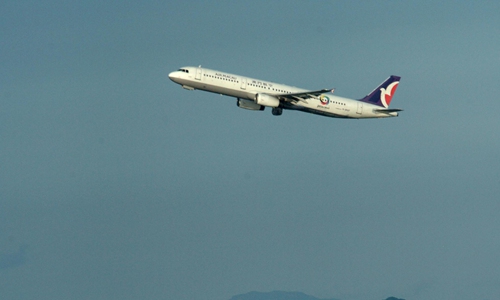HOME >> SOURCE
Taxi, takeoff, and lucrative landings
Source:Global Times Published: 2019/12/19 17:23:42
Air Macau to benefit more from the Greater Bay Area

A view of an aircraft of Air Macau File photo: CNSphoto
Air Macau has celebrated its 25th anniversary as some say it's apparent the carrier will win more opportunities with the development of Guangdong-Hong Kong-Macao Greater Bay Area (GBA).Amid the construction of the GBA, the Macao Special Administrative Region (SAR) aims to coordinate with South China's Guangzhou, Shenzhen, Zhuhai and the Hong Kong SAR to develop a world-class airport cluster.
The GBA has a population of 70 million and a combined GDP of $1.6 trillion, which combine to craft the prospect of a collective economic powerhouse. Under the Outline Development Plan for the Guangdong-Hong Kong-Macao Greater Bay Area released by the central government in Februrary, five main airports and a batch of feeder airports in the GBA constitute the airport cluster.
On January 13, Air Macau will open a route from Macao SAR to Beijing Daxing International Airport, marking the first flight from the SAR to the new mega airport.
Founded in September 1994, the carrier now has an all-Airbus fleet of 21 aircraft. As of November 2019, the carrier operates a total of 28 domestic and international routes, covering Chinese mainland, Taiwan, Southeast Asia and Northeast Asia.
The carrier made profits for nine consecutive years since 2010.
Chen Hong, president of executive committee cum chief executive officer said "under the GBA, the airports within the region will reinforce their specific roles by sharing workload and passenger flow."
"In this era, we should embrace the concept of 'competition and cooperation'," Chen was quoted as saying by a report of macaomagazine.net in March.
With the launch of the Hong Kong-Zhuhai-Macao Bridge, Macau International Airport and Hong Kong International Airport can further cooperate with each other by dividing their workload, he explained.
The carrier is expected to maintain a 10 percent growth rate annually, which is in line with the internal resources of the company, said Zeng Hualiang, vice president of the company in the report.
The carrier has even more reasons to be optimistic.
Macau International Airport saw increasing growth in passenger and flight volume in the first 11 months of this year, handling a total of more than 8.7 million passengers and more than 71,000 flights, a 16 percent and 19 percent increase over the same period last year, respectively. It is expected that in the whole year of 2019, it will handle 9.5 million passengers and move toward the ranks of large airports with a passenger throughput of 10 million.
Since 2001, five main airports in the Greater Bay Area - Hong Kong International Airport, Guangzhou Baiyun International Airport, Shenzhen Bao'an International Airport, Macau International Airport and Zhuhai Airport - have been strengthening collaboration and promoting mutual interests.
Macau International Airport is positioned as a small- and medium-sized airport, said Vicki Mou, chief of corporate communication and policy research office of Macau International Airport, according to Xinhua News Agency.
Aside from regional business aircraft services, the airport focuses on Southeast Asian markets, connecting Macao and many attractions in the Philippines, Thailand, Malaysia and some other Southeast Asian countries, which enrich international routes in the Greater Bay Area, said Mou.
With tourist season coming, the airport is planning for more routes, and there will be new destinations in the fourth quarter, including Chengdu Airlines which will open a route from Macao to Chengdu, capital of Southwest China's Sichuan Province and Yiwu, East China's Zhejiang Province.
Visitor arrivals in Macao increased by 1.8 percent year-on-year to 3.21 million in October, the SAR's statistics department said last month.